Cotton bed sheets offer superior softness and moisture absorption, making them ideal for year-round comfort. Linen bed sheets provide enhanced breathability and durability, perfect for hot climates and long-term use.
Table of Comparison
| Feature | Cotton | Linen |
|---|---|---|
| Breathability | High, soft and comfortable | Very high, excellent airflow |
| Durability | Moderate, prone to wear over time | High, stronger with age |
| Moisture-Wicking | Good, absorbs moisture effectively | Excellent, dries quickly |
| Texture | Soft and smooth | Coarse initially, softens after washes |
| Maintenance | Easy, machine washable | Requires gentle care, machine washable on delicate |
| Wrinkle Resistance | Moderate, less prone to wrinkles | Low, wrinkles easily |
| Hypoallergenic | Yes, suitable for sensitive skin | Yes, naturally hypoallergenic |
| Cost | Affordable | Higher price point |
Overview: Cotton vs Linen Bed Sheets
Cotton bed sheets offer a soft, breathable texture with excellent moisture absorption, making them ideal for year-round comfort and easy care. Linen bed sheets provide a natural, durable fabric with superior airflow and a slightly textured feel that enhances cooling, especially in warm climates. Both materials vary in durability and maintenance, with cotton being smoother and easier to launder, while linen tends to soften with each wash and offers a more rustic aesthetic.
Fabric Composition and Characteristics
Cotton bed sheets are made from natural fibers harvested from the cotton plant, known for their softness, breathability, and moisture-wicking properties. Linen sheets, derived from flax fibers, offer superior durability, a textured feel, and excellent temperature regulation, making them ideal for warm climates. Both fabrics provide hypoallergenic benefits, but cotton tends to be smoother, while linen becomes softer and more absorbent with each wash.
Comfort and Feel: Cotton vs Linen
Cotton bed sheets offer a soft, smooth texture with excellent breathability, making them ideal for a cozy and gentle feel against the skin. Linen sheets provide a slightly rougher, textured surface that softens with each wash, offering superior moisture-wicking and temperature-regulating properties for a cool, crisp comfort. Both fabrics excel in comfort, with cotton favoring softness and linen emphasizing durability and breathability.
Breathability and Temperature Regulation
Linen bed sheets offer superior breathability due to their loosely woven fibers, enabling better air circulation and moisture-wicking compared to cotton. Cotton sheets, particularly those made from long-staple or Egyptian cotton, provide soft comfort but retain more heat, making them less efficient for temperature regulation. For hot sleepers or warm climates, linen sheets help maintain a cooler, drier sleeping environment by effectively reducing night sweats and overheating.
Durability and Longevity
Linen bed sheets exhibit superior durability due to their long, strong flax fibers, which resist wear and pilling better than cotton. High-quality cotton sheets, particularly those made from Egyptian or Pima cotton, offer softness but typically have a shorter lifespan compared to linen. Over time, linen sheets become softer and more breathable while retaining their structural integrity, making them a long-lasting investment for bedding.
Maintenance and Care Tips
Cotton bed sheets require regular washing at warm temperatures and benefit from occasional fabric softeners to maintain softness and breathability, while linen sheets need gentle washing in cool water to preserve fibers and prevent shrinkage. Avoid using bleach or harsh detergents on both fabrics to extend their lifespan, and linen benefits from air drying to reduce wrinkles, whereas cotton tolerates machine drying better. Frequent ironing is less necessary for cotton, but linen sheets often require light ironing or steaming to maintain their crisp texture.
Hypoallergenic Properties
Cotton bed sheets are naturally hypoallergenic, making them ideal for sensitive skin and allergy sufferers due to their breathability and moisture-wicking capabilities. Linen sheets also offer hypoallergenic benefits, as their fibers resist bacteria and fungi while promoting airflow to reduce irritation. Both fabrics provide excellent options for allergy-prone individuals, with cotton offering a softer feel and linen delivering enhanced durability and temperature regulation.
Cost Comparison: Value for Money
Cotton bed sheets typically offer a more affordable price point compared to linen, making them a popular choice for budget-conscious shoppers seeking value for money. Linen sheets, while often pricier, provide enhanced durability and breathability that can justify the higher initial investment through long-term use. Evaluating the cost per use highlights linen's potential savings over time despite its higher upfront cost, whereas cotton remains ideal for those prioritizing immediate affordability.
Environmental Impact and Sustainability
Cotton bed sheets generally have a higher environmental footprint due to intensive water usage and pesticide application in conventional farming, whereas linen, derived from flax plants, requires significantly less water and fewer chemicals, making it a more sustainable choice. Linen's natural biodegradability and its ability to grow in poorer soil conditions without heavy irrigation contribute to reduced environmental impact. Choosing organic cotton or sustainably sourced linen bed sheets enhances eco-friendliness by supporting soil health and minimizing pollution.
Which is Better: Choosing the Right Fabric for You
Cotton bed sheets offer exceptional softness, breathability, and durability, making them ideal for year-round comfort and easy maintenance. Linen sheets excel in moisture-wicking and temperature regulation, providing a cool and fresh feel, especially suited for hot climates and allergy-sensitive individuals. Choosing between cotton and linen depends on your priorities: select cotton for a smooth, soft texture or linen for superior airflow and a natural, textured finish.

Infographic: Cotton vs Linen for Bed Sheet
 azmater.com
azmater.com